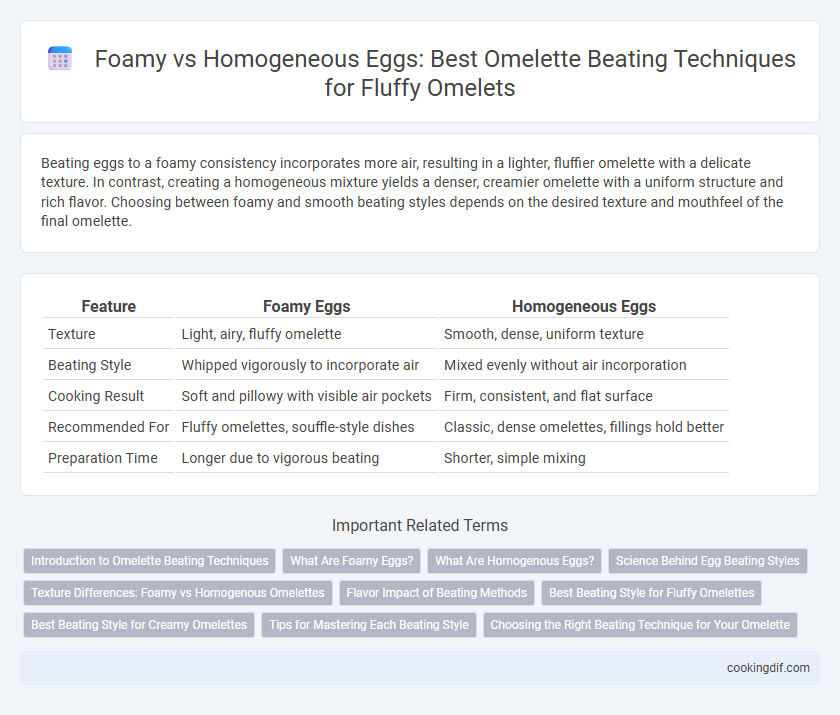Beating eggs to a foamy consistency incorporates more air, resulting in a lighter, fluffier omelette with a delicate texture. In contrast, creating a homogeneous mixture yields a denser, creamier omelette with a uniform structure and rich flavor. Choosing between foamy and smooth beating styles depends on the desired texture and mouthfeel of the final omelette.
Table of Comparison
| Feature | Foamy Eggs | Homogeneous Eggs |
|---|---|---|
| Texture | Light, airy, fluffy omelette | Smooth, dense, uniform texture |
| Beating Style | Whipped vigorously to incorporate air | Mixed evenly without air incorporation |
| Cooking Result | Soft and pillowy with visible air pockets | Firm, consistent, and flat surface |
| Recommended For | Fluffy omelettes, souffle-style dishes | Classic, dense omelettes, fillings hold better |
| Preparation Time | Longer due to vigorous beating | Shorter, simple mixing |
Introduction to Omelette Beating Techniques
Foamy eggs, created by vigorous whisking, incorporate air that results in a light and fluffy omelette texture, enhancing volume and tenderness. Homogenous eggs, beaten gently until uniform, produce a denser and smoother omelette, emphasizing a consistent and creamy mouthfeel. Understanding these beating techniques allows chefs to customize omelette textures, optimizing flavor and presentation based on desired culinary outcomes.
What Are Foamy Eggs?
Foamy eggs are created by vigorously whisking egg whites until they develop a light, airy texture filled with tiny bubbles, resulting in a frothy mixture that adds volume and fluffiness to omelettes. This foamy consistency traps air, which expands during cooking to produce a lighter, softer omelette compared to the dense, uniform texture of homogenous eggs that are beaten just until combined. Using foamy eggs in omelette preparation enhances the dish's tenderness and creates a more delicate mouthfeel, making it a preferred technique for chefs aiming for a fluffy, souffle-like finish.
What Are Homogenous Eggs?
Homogenous eggs refer to eggs beaten until the yolk and white are fully blended into a smooth, uniform mixture without any visible bubbles or foam. This style creates a consistent texture that allows the omelette to cook evenly and develop a tender, cohesive structure. Unlike foamy eggs, which incorporate air for fluffiness, homogenous eggs produce a denser and more uniform omelette with a velvety finish.
Science Behind Egg Beating Styles
Foamy eggs result from vigorous beating that incorporates air, creating a lighter texture ideal for fluffy omelettes, as air bubbles expand when cooked. Homogeneous eggs, beaten gently to blend yolks and whites uniformly, produce a denser, creamier omelette with a smooth consistency. The science behind these styles revolves around the degree of protein denaturation and air incorporation, affecting the omelette's rise, texture, and mouthfeel.
Texture Differences: Foamy vs Homogenous Omelettes
Foamy eggs produce an airy, light texture with visible bubbles, creating a fluffy and tender omelette ideal for a delicate bite. Homogenous eggs result in a smooth, uniform mixture that yields a denser, creamier omelette with a consistent texture throughout. The choice between foamy and homogenous beating directly impacts the mouthfeel and visual appeal of the finished omelette.
Flavor Impact of Beating Methods
Foamy eggs create air pockets that result in a light and airy omelette, enhancing its texture but slightly diluting rich egg flavor due to increased volume. Homogeneous eggs produce a denser, creamier omelette with a more concentrated and intense egg taste, as the proteins remain tightly bound during beating. The choice between foamy and homogeneous beating methods directly influences the flavor intensity and mouthfeel of the final omelette.
Best Beating Style for Fluffy Omelettes
Foamy eggs create numerous air bubbles, resulting in a light and airy omelette texture that enhances fluffiness. Homogeneous beating evenly mixes yolks and whites, producing a consistent, creamy structure with less volume. For the best fluffy omelette, lightly whisking to incorporate air without over-beating strikes the ideal balance between foaminess and smoothness.
Best Beating Style for Creamy Omelettes
Foamy eggs create air bubbles that result in a light, fluffy texture, ideal for airy omelettes, while homogenous eggs blend yolks and whites uniformly, producing a dense, creamy consistency. Beating eggs gently just until combined without over-whipping preserves moisture and ensures a smooth, custard-like omelette surface. For the creamiest omelette, choose the homogenous beating style, mixing eggs thoroughly but avoiding excessive foam to maintain richness and a velvety mouthfeel.
Tips for Mastering Each Beating Style
Foamy eggs, beaten vigorously to incorporate air, create a light and airy omelette with a fluffy texture, ideal for a delicate finish; using a whisk or electric mixer at high speed ensures optimal foam formation. Homogeneous eggs, beaten gently until uniform and smooth, yield a denser, creamier omelette that holds fillings well, best achieved with a fork or balloon whisk using steady, controlled strokes. Mastering these techniques involves adjusting beating time and tools to balance texture and structure for the perfect omelette consistency.
Choosing the Right Beating Technique for Your Omelette
Foamy eggs, achieved by vigorous whisking, incorporate air for a light, fluffy omelette texture, ideal for souffle-style or delicate breakfast dishes. Homogeneous eggs, beaten gently until smooth and uniform, produce a denser, creamier omelette with a consistent texture, preferred for traditional French-style preparations. Selecting the beating style depends on your desired omelette texture and cooking method, ensuring optimal flavor and mouthfeel.
Foamy eggs vs homogenous eggs for omelette beating style Infographic

 cookingdif.com
cookingdif.com